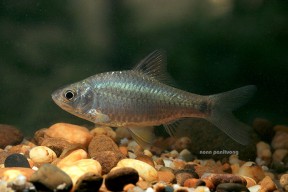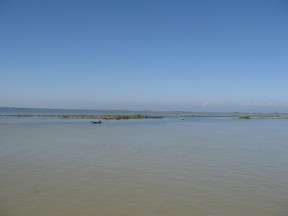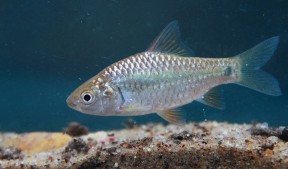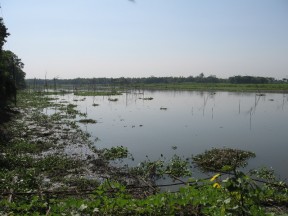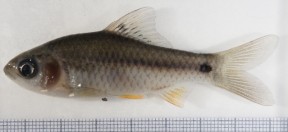Puntius chola
Swamp Barb
SynonymsTop ↑
Cyprinus chola Hamilton, 1822; Barbus chola (Hamilton, 1822); Puntius chola (Hamilton, 1822); Cyprinus titius Hamilton, 1822; Systomus tetrarupagus McClelland, 1839; Leuciscus thermalis Valenciennes, in Cuvier & Valenciennes, 1844: ? Systomus unimaculatus Blyth, 1860; Puntius perlee Day, 1865
Etymology
Puntius: from the Bengali pungti, a vernacular term for small cyprinids.
chola: appears to follow a local vernacular name for the fish.
Classification
Order: Cypriniformes Family: Cyprinidae
Distribution
Currently accepted to range throughout much of Pakistan, India, Nepal, Bhutan, Bangladesh, Sri Lanka, Myanmar, and western Thailand.
Type locality is ‘Northeastern parts of Bengal’.
Habitat
Probably varies with locality and time of year but likely to be found in minor streams, rivers, irrigation canals, oxbow lakes, and associated water bodies rather than main river channels, entering temporarily inundated zones such as beels and haors during the wet season.
It apparently shows a preference for stiller waters and substrates of mud or silt.
As an example, in a survey of fish diversity in the Bhadra River, Karnataka state, southern India, it was recorded alongside numerous other species including Botia striata, Balitora mysorensis, and Mystus armatus.
Dry season water paramaters were temperature 69.8°F/21°C, pH 7.0, hardness ~ 2.5°.
The substrate was composed of bedrock, boulders, cobbles, gravel, sand and leaf litter in descending order of abundance, maximum water depth was around 1.5 m, and there was a degree of forest cover.
Maximum Standard Length
80 – 130 mm.
Aquarium SizeTop ↑
Base dimensions of at least 120 ∗ 45 cm or equivalent are required for long-term care.
Maintenance
Fairly easy to maintain provided a dedicated maintenance routine is adhered to, with choice of décor is more-or-less down to personal taste.
A natural-style arrangement could include a substrate of sand or gravel with plenty of larger, water-worn rocks and pebbles plus some driftwood or twisted roots and branches.
Lighting can be relatively subdued and plants able to grow in such conditions from genera such as Microsorum, Taxiphyllum, or Anubias spp. added if you wish.
Water Conditions
Temperature: 18 – 26 °C
pH: 5.5 – 8.0
Hardness: 36 – 268 ppm
Diet
Likely to be a foraging omnivore feeding on worms, insects and other small invertebrates, as well as plant material and organic detritus.
In the aquarium it is easily-fed but the best condition and colours offer regular meals of small live and frozen foods such as bloodworm, Daphnia, and Artemia, alongside good quality dried flakes and granules, at least some of which should include additional plant or algal content.
Behaviour and CompatibilityTop ↑
This species makes an ideal addition to a peaceful community of riverine fishes such as similarly-sized cyprinids plus many botiid, nemacheilid and balitorid loaches.
If geography isn’t an issue it can actually be combined with most peaceful fish of a size too large to be considered food and that have a bold enough disposition to not be intimidated by its size and active nature.
As always, thorough research is the best way to avoid problems when selecting compatible fish communities.
It is a schooling species by nature so ideally 6 or more specimens should be purchased.
Maintaining it in decent numbers will not only make the fish less skittish but result in a more effective, natural-looking display, plus any aggressive behaviour will normally be contained as the fish concentrate on maintaining their hierarchical position within the group.
Sexual Dimorphism
Adult females tend to grow a little larger, are heavier-bodied, and less colourful than males.
Males also have orangish anal and pelvic fins whereas females do not and nuptial individuals of some populations develop a red lateral stripe extending from the opercle to the caudal peduncle.
Reproduction
Unrecorded.
NotesTop ↑
This species is sometimes referred to as ‘chola’ or ‘green’ barb.
It is characterised by possession of a single pair of barbels and a colour pattern comprising a dark blotch behind the operculum and another near the base of the caudal-fin.
The genus Puntius was viewed as a polyphyletic catch-all containing over 100 species of small to mid-sized cyprinid for a number of years until Pethiyagoda et al. (2012) published a partial review covering South Asian members.
The majority of sub-Himalayan Puntius species were reclassified and new genera Dawkinsia, Dravidia, and Pethia erected to accommodate some of them, with the remainder either retained in Puntius or moved to the existing Systomus assemblage, though the definition of the latter was altered meaning some Southeast Asian species formerly placed there are no longer members.
It subsequently became clear that the name Dravidia was preoccupied by a genus of flesh fly, therefore the replacement name Haludaria was made available by Pethiyagoda (2013).
P. chola was retained in Puntius sensu stricto, of which members are defined by the following combination of characters: adult size usually less than 120 mm SL; maxillary barbels absent or present; rostral barbels absent; 3-4 unbranched and 8 branched dorsal-fin rays; 3 unbranched and 5 branched anal-fin rays; last unbranched dorsal-fin ray weak or strong and unserrated; lateral line complete with 22-28 pored body scales; free uroneural present; gill rakers simple and acuminate (not branched or laminate); no antrorse predorsal spinous ray; post-epiphysial fontanelle usually present (except in P. bimaculatus and P. titteya); 4 supraneurals; infraorbital 3 slender; 5th ceratobranchial narrow; pharyngeal teeth 5 + 3 + 2; 12-14 abdominal and 14-16 caudal vertebrae; colour pattern including a (sometimes faint) blackish spot on the caudal peduncle.
No species from Indochina, China, or Indonesia were included in the study meaning some former Puntius are currently classed as incertae sedis, i.e., of uncertain taxonomic placement. Several of these issues were resolved by Kottelat (2013) who raised new genera for a number of Southeast Asian species.
References
- Hamilton, F., 1822 - Edinburgh & London: i-vii + 1-405
An account of the fishes found in the river Ganges and its branches. - Kottelat, M., 2013 - The Raffles Bulletin of Zoology Supplement 27: 1-663
The fishes of the inland waters of southeast Asia: a catalogue and core bibiography of the fishes known to occur in freshwaters, mangroves and estuaries. - Kumar, K. K., F. G. Benno Pereira, and K. V. Radhakrishnan, 2012 - Biosystematica 5(2): 31-37
Puntius madhusoodani (Teleostei: Cyprinidae), a new species of barb from Manimala River, Kerala, South India. - Pethiyagoda, R., 2013 - Zootaxa 3646(2): 199
Haludaria, a replacement generic name for Dravidia (Teleostei: Cyprinidae). - Pethiyagoda, R., A. Silva, K. Maduwage and M. Meegaskumbura, 2008 - Ichthyological Exploration of Freshwaters 19(3): 201-214
Puntius kelumi, a new species of cyprinid fish from Sri Lanka (Teleostei: Cyprinidae). - Pethiyagoda, R., M. Meegaskumbura, and K. Maduwage, 2012 - Ichthyological Exploration of Freshwaters 23(1): 69-95
A synopsis of the South Asian fishes referred to Puntius (Pisces: Cyprinidae). - Shantakumar, M. and W. Vishwanath, 2006 - Zoos' Print Journal 21(6): 2279-2283
Inter-relationships of Puntius Hamilton-Buchanan (Cyprinidae: Cyprininae) found in Manipur, India. - Silva, A., K. Maduwage, and R. Pethiyagoda, 2008 - Zootaxa 1824: 55-64
Puntius kamalika, a new species of barb from Sri Lanka (Teleostei: Cyprinidae). - Vishwanath, W. and J. Laisram, 2004 - Journal of the Bombay Natural History Society 101(1): 130-137
Two new species of Puntius Hamilton-Buchanan (Cypriniformes: Cyprinidae) from Manipur, India, with an account of Puntius species from the state.
